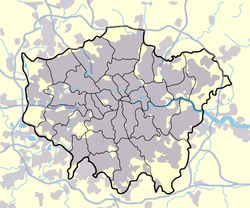

London is the largest urban area and the capital city of the United Kingdom. It lies in the southeastern part of the island of Great Britain. The London region covers 1,579 square kilometres (610 sq mi), and had a population of 8.982 million in 2019 and a population density of 5,596 people per square km in 2021. A larger area—the London Metropolitan Region or the London Metropolitan Agglomeration—covers 8,382 square kilometres (3,236 sq mi) and had 12,653,500 people, at a density of 1,510 per square kilometre.[1]
London is a port on the Thames (see main article Port of London), a navigable river. The river has had a major influence on the development of the city. London began on the Thames' north bank and for a long time the main focus of the city remained on the north side of the Thames. For many centuries London Bridge was the only bridge in or close to the city. When more bridges were built in the 18th century, the city expanded in all directions as the mostly flat or gently rolling countryside presented no obstacle to growth.
- ^ "Metropolis: 027 London, World Association of the Major Metropolises" (PDF). Archived from the original (PDF) on 27 April 2011. Retrieved 3 May 2010.
© MMXXIII Rich X Search. We shall prevail. All rights reserved. Rich X Search
